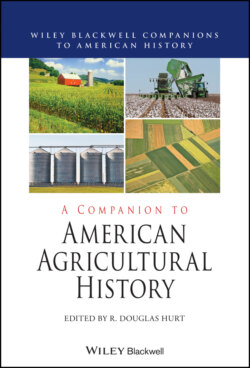Читать книгу A Companion to American Agricultural History - Группа авторов - Страница 12
Chapter 1 NATIVE AMERICAN AGRICULTURE BEFORE EUROPEAN CONTACT
ОглавлениеGayle Fritz
The history of food production in North America before European contact is deep and diverse, with traditions that vary geographically and culturally. Archaeologists, historians, geographers, botanists, and agronomists have studied pre-Columbian agriculture for more than a century, and it remains a widely discussed topic in textbooks and scholarly publications. Members of the general public are also intrigued by information about past Native American farming. These studies, after all, reveal where some of our foods came from and how people grew crops in challenging environments without metal tools or modern mechanical devices. The past might even hold clues to help us cope with issues such as climate change and to explore alternative methods to the low-diversity, high-energy input systems practiced by most American farmers today.
Eastern North America was one of the world’s independent centers of plant domestication (Bellwood 2005; Smith 2011; Langlie et al. 2014). Thousands of years before the arrival of maize, kidney beans, or Mexican squashes, a local squash and a group of native seed-bearing plants were domesticated, constituting the Eastern Agricultural Complex (Figures 1.1 and 1.2). The local, eastern squash and sunflowers survive to this day as popular food crops, but most Eastern Agricultural Complex crops fell out of Native American cuisines several centuries prior to the earliest written records, or became such minor foods that they were not included in archival accounts. These “lost crops” have only recently gained the respect they deserve as pre-maize staples and plants whose nutritional properties make them candidates for de-extinction (Mueller et al. 2017; Mueller, White, and Szilagyi 2019).
Figure 1.1 Map of North America showing locations of sites mentioned in text. The area enclosed inside the dotted oval line is the core region within which early Native American farmers grew Eastern Agricultural Complex crops. Map by and with the permission of Kelly Ervin.
Maize was domesticated in southern Mexico no later than 7000 years ago (Blake 2015). Maize that spread into eastern North America seems to have come across the Plains from the Southwest, where it was grown by at least 2100 BCE. Although maize agriculture in the Southwest was not preceded by production of locally domesticated crops, farmers in this arid zone developed effective water management systems and strategies of situating fields in the most optimal locations (Cordell and McBrinn 2012). They also selected and bred drought-hardy landraces to comprise distinctive regional crop complexes. In the Hohokam region of southern and central Arizona, large-scale irrigation canals directed water to fields from permanent rivers, while agave plants were grown in extensive rockpile fields along lower slopes of hillsides (Fish and Fish 2014).
Northwest Coast and Interior Plateau societies, long classified as non-agricultural fisher-hunter-gatherers, are now recognized for intricate landscape management practices, including cultivation, that increased the productivity of staple root crops, berries, and other plant foods (Peacock and Turner 2000; Deur and Turner 2005). It is difficult to date the antiquity of these strategies, but there is no doubt that they predate European influence. Combined archaeological and ethnobotanical studies that include authors who belong to Canadian First Nations and US Native American communities expand our knowledge about when and where early residents of the Pacific Northwest applied these methods and how their coastal gardens and upland garden-like meadows fit into long-term cultural trajectories in this densely populated region.
I begin this chapter with a review of plant domestication in eastern North America’s Midwest riverine area, focusing first on the Eastern Agricultural Complex, and moving forward in time to maize-based agriculture. The next section is devoted to crops and farmers in the Southwest, where both regional diversity and changes through time are reflected in the archaeological record. In the following section, I cover the Pacific Northwest, summarizing evidence for landscape domestication that included crop cultivation. I conclude by discussing the significance of Native American farming systems for their productivity and efficiency and for the relevance they hold for Americans today.
